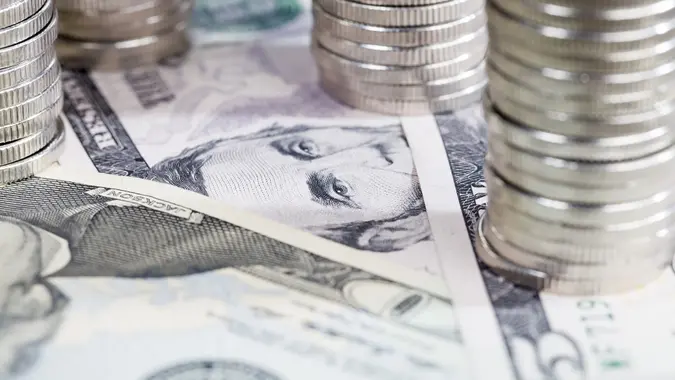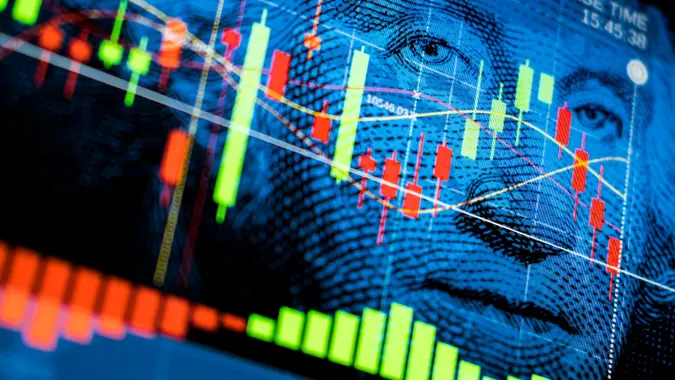How Often Do CD Rates Change? Key Factors Explained

Commitment to Our Readers
GOBankingRates' editorial team is committed to bringing you unbiased reviews and information. We use data-driven methodologies to evaluate financial products and services - our reviews and ratings are not influenced by advertisers. You can read more about our editorial guidelines and our products and services review methodology.

20 Years
Helping You Live Richer

Reviewed
by Experts

Trusted by
Millions of Readers
Once you open and fund a CD, your rate is locked for the duration of the term. However, if you’re still shopping around, you may notice the same bank offers a different rate from one day to the next.
When a financial institution changes CD rates, it might increase or decrease rates for some terms and not others. Or it might increase rates for some terms and decrease them for others. Here are some of the reasons that CD rates can fluctuate.
Economic Conditions
Economic conditions affect federal interest rates, which influence consumer interest rates, including rates on CDs.
The Federal Reserve’s federal funds rate indirectly influences CD rates. When the Fed rate increases or decreases, CD rates tend to follow. Be aware that it may take several weeks or months to see the changes.
Inflation
To fight inflation, the Federal Reserve usually increases the federal funds rate to slow the economy, and CD rates might eventually follow. In 2022, the Fed raised rates multiple times to fight inflation and CD rates jumped from under 1% to over 5% APY by mid-2023.
Recession
The Federal Reserve often lowers the federal funds rate during recessions to spark economic growth and lower unemployment numbers. For example, during the Great Recession (2007-2009), the Fed rate dropped from 5.6% to just 0.12%, taking CD rates down with it.
Bank-Specific Strategies
Banks consider a variety of factors in settings rates on CDs and other interest-bearing accounts.
Competition Among Banks
Banks want your business, and competitive CD rates are one way to attract it. If one bank boosts its APY, others may follow.
Look out for “CD specials” with odd terms like 11 or 13 months. These are promotional offers that often pay more than standard CDs.
Internal Bank Goals and Balance Sheets
Banks manage risk by adjusting deposit flows. If they need more deposits, they may temporarily raise rates. If they’re flush with cash, they may lower them. You’re effectively lending money to the bank, and rates reflect what they’re willing to pay for that loan.
Seasonal and Cyclical Trends in CD Rates
Seasonal and cyclical trends can make rate changes more likely even if they don’t impact the rates directly. A bank also might shift its pricing strategy in response to its earnings reports if the financial results suggest action is needed.
While CD rates aren’t seasonal by nature, you may notice rate shifts around key financial events, like:
- Tax season (Feb-Apr): When people deposit refunds, banks may lower rates
- End of quarter or fiscal year: Banks may adjust rates to meet asset targets
- Business cycles: Rates rise during economic expansions and fall during contractions
On a broader scale, the Federal Reserve keeps the economy in check by raising and lowering the federal funds rate in response to different stages of the business cycle — the name for the continuous cycle of economic expansion and contraction, along with the peaks and troughs that signal transitions between the two.
Can You Predict CD Rate Changes?
Unfortunately, no. Predicting rate changes is like trying to time the stock market. Even the most educated forward-looking prediction is just guess.
But if you’re interested in the banking industry and how the economy works, you can watch rates and tap into resources that tell you what economists are thinking about where rates might be headed. Note, however, that even experts change their predictions frequently based on new developments.
- Rate comparison resources: GOBankingRates and other sites post the latest CD rates from a number of financial institutions. Also check the banks’ own sites to see rates for all the terms they offer.
- FDIC: The Federal Deposit Insurance Corp. publishes national average rate information each month and provides easy access to rates from previous months.
- Federal Reserve: The Federal Open Market Committee is the body that decides on federal funds rate changes during eight scheduled meetings per year. You can access the meeting calendar and transcripts of the Fed chair’s statements on the group’s decisions here.
- FedWatch: FedWatch is a tool from the CME Group that tracks the likelihood of changes to the federal funds rate. It includes the “dot plot” — the chart showing what FOMC members themselves predict the committee will do over various time periods.
How to Mazimize Your Returns Despite CD Rate Fluctuations
With the right strategy, you can maximize your returns in any CD rate environment.
Ladder Your CDs
A CD ladder is a bundle of CDs with different terms, selected to let you take advantage of the most favorable rates while assuring regular access to your money.
If 12-month CDs are paying the highest rates but you don’t want to tie up your money for a whole year, you might build a ladder with three-, six- and 12-month CDs. When the three-month CD matures, you can put the money in a new 12-month CD, then do the same when the six-month CD matures. You’ll eventually have three 12-month CDs earning the top rates, but with staggered maturity dates that let you access your money three times a year.
Diversify Your Savings
Spreading your savings across different types of high-yielding accounts helps to ensure that some of your money is always earning the highest possible rate, and some is always accessible. Rather than ladder CDs, you might purchase just one and put the rest of your savings in a high-yield savings account, which can earn earn similar yields.
Treasury bills are another option. The rates are competitive with some of the highest rates banks and credit unions offer, and they’re available in a variety of terms.
Other high-yielding Treasurys include notes and bonds. One, a Treasury inflation-protected bond, or TIP, has a variable principle that that keeps up with inflation — something savings accounts and CDs don’t always do. You can purchase Treasurys from the TreasuryDirect website, located here.
The Bottom Line
CD rates change based on the economy, the bank’s priorities and interest changes from the federal reserve. Sometimes, rates can change multiple times per year.
By staying informed, building a CD ladder and mixing in flexible accounts like high-yield savings or Treasury bills, you can grow your savings with confidence — no matter what the market does.
Kathy Evans contributed to the reporting for this article.
Our in-house research team and on-site financial experts work together to create content that’s accurate, impartial, and up to date. We fact-check every single statistic, quote and fact using trusted primary resources to make sure the information we provide is correct. You can learn more about GOBankingRates’ processes and standards in our editorial policy.
- Comerica. "Fixed Rate CDs."
- FDIC. "National Rates and Rate Caps - Previous Rates."
- Federal Reserve Bank of St. Louis. "Federal Funds Effective Rate."
- Marcus by Goldman Sachs. 2024. "How to Build a CD Ladder."
- U.S. Department of the Treasury. "Daily Treasury Bill Rates."
- TreasuryDirect. "Treasury Inflation Protected Securities (TIPS)."
 Written by
Written by  Edited by
Edited by 
























